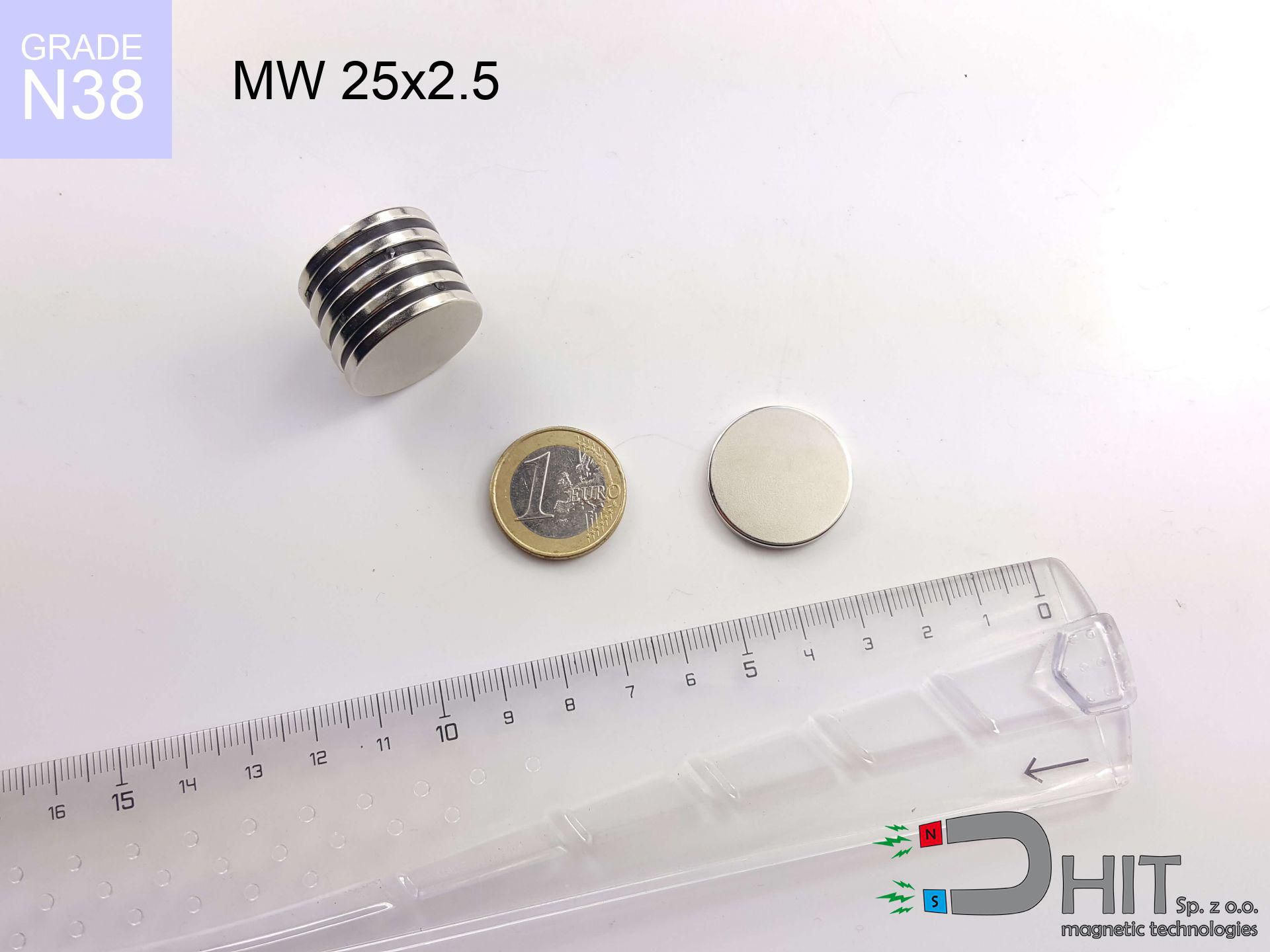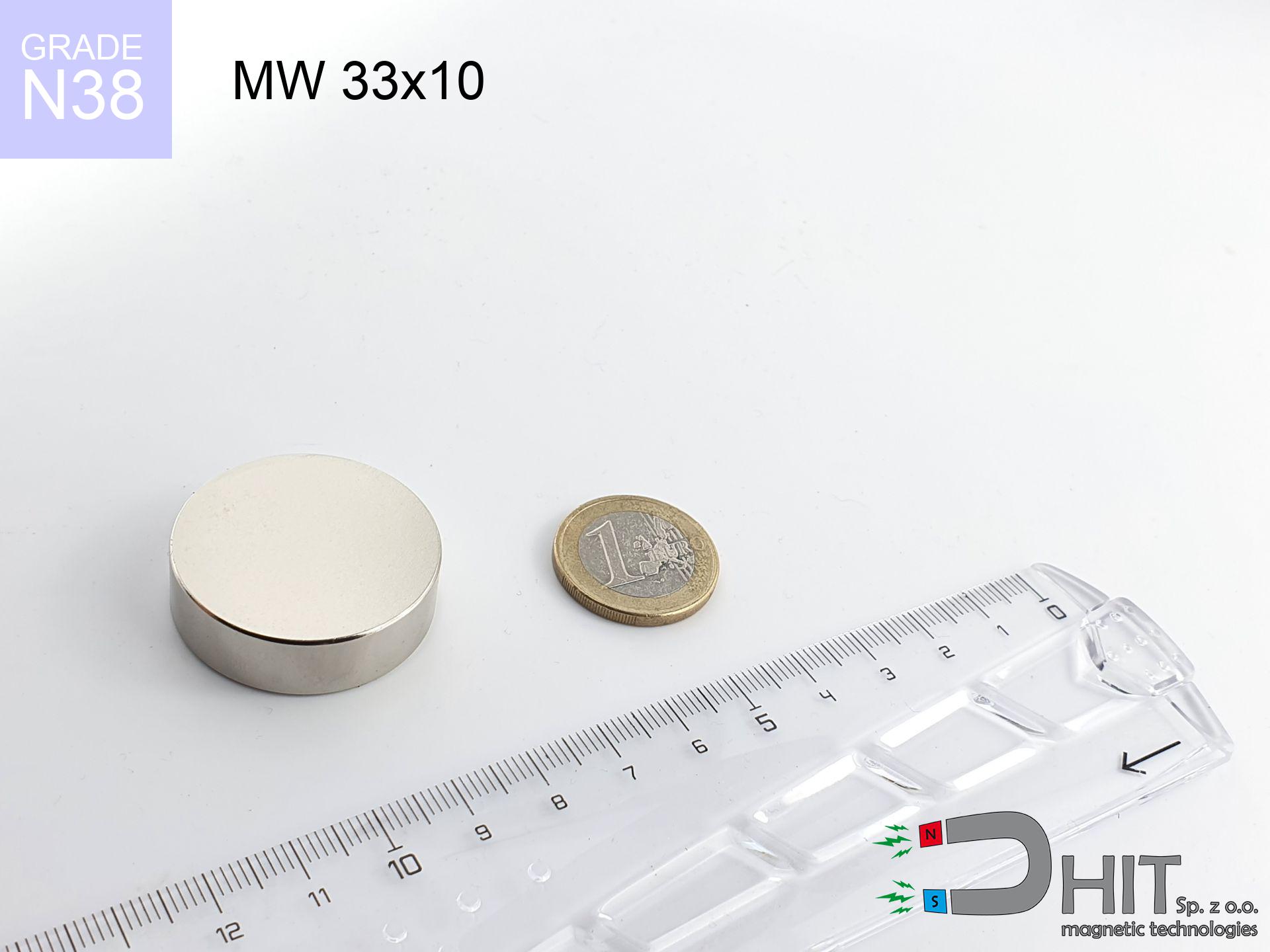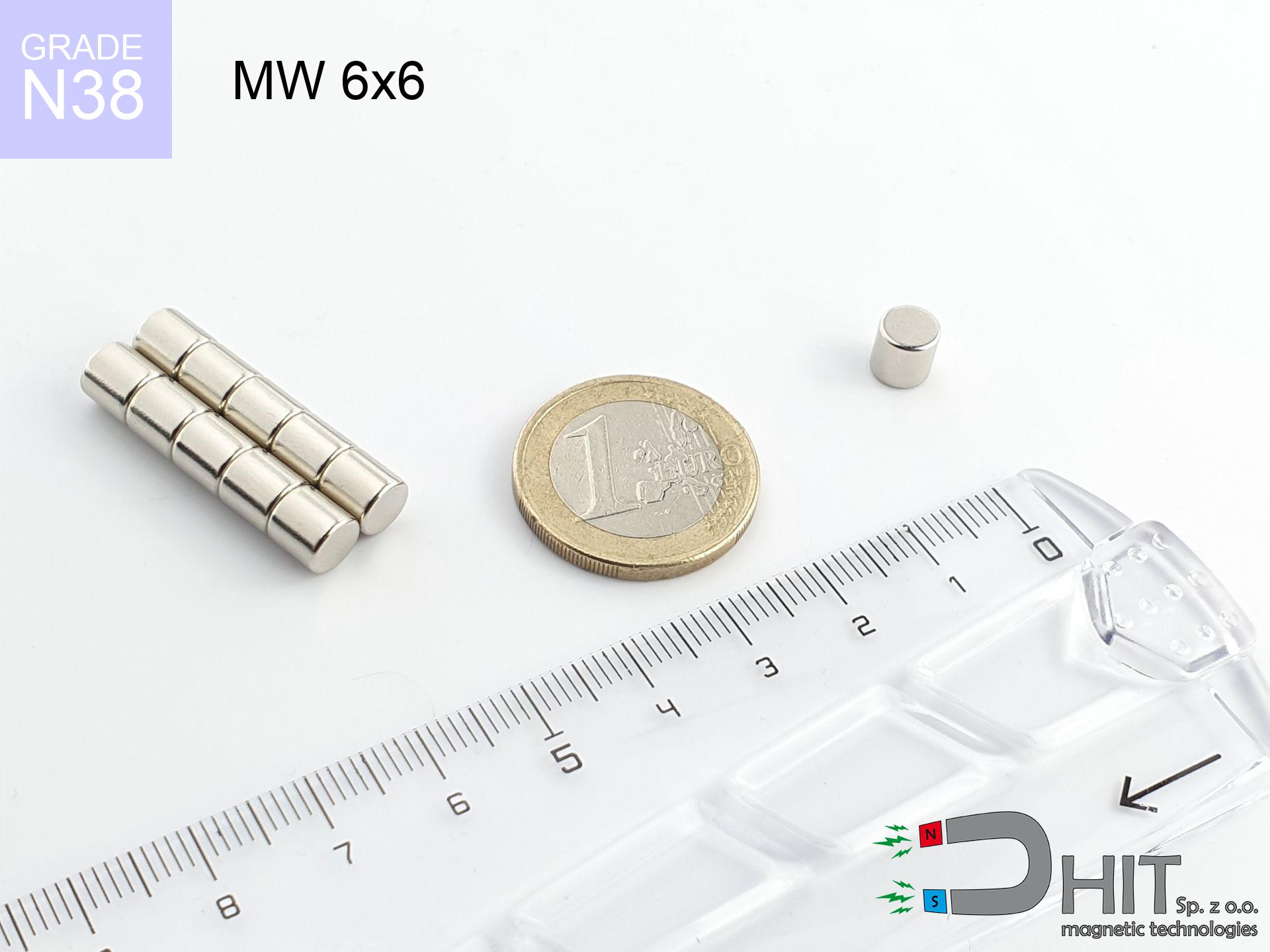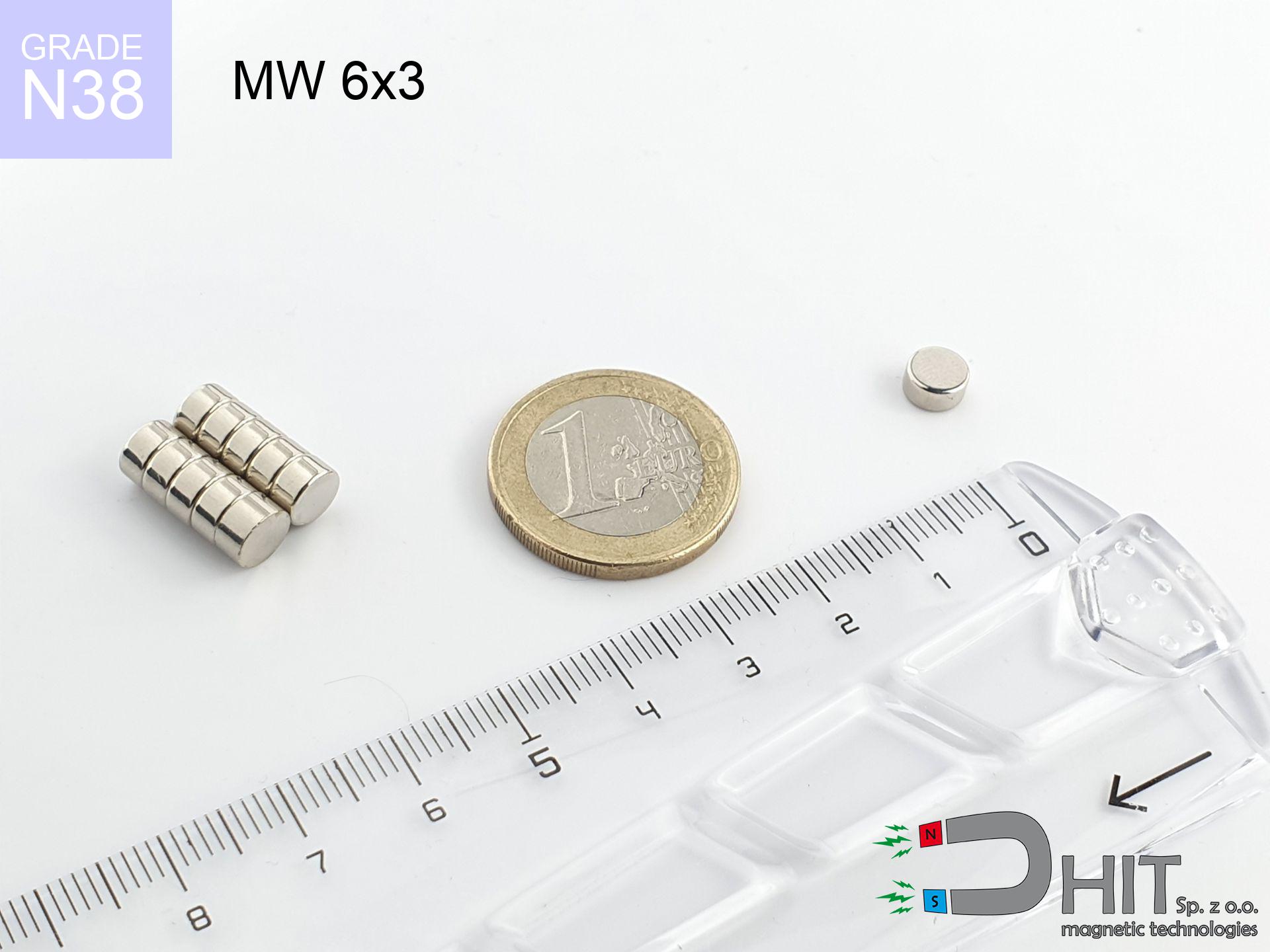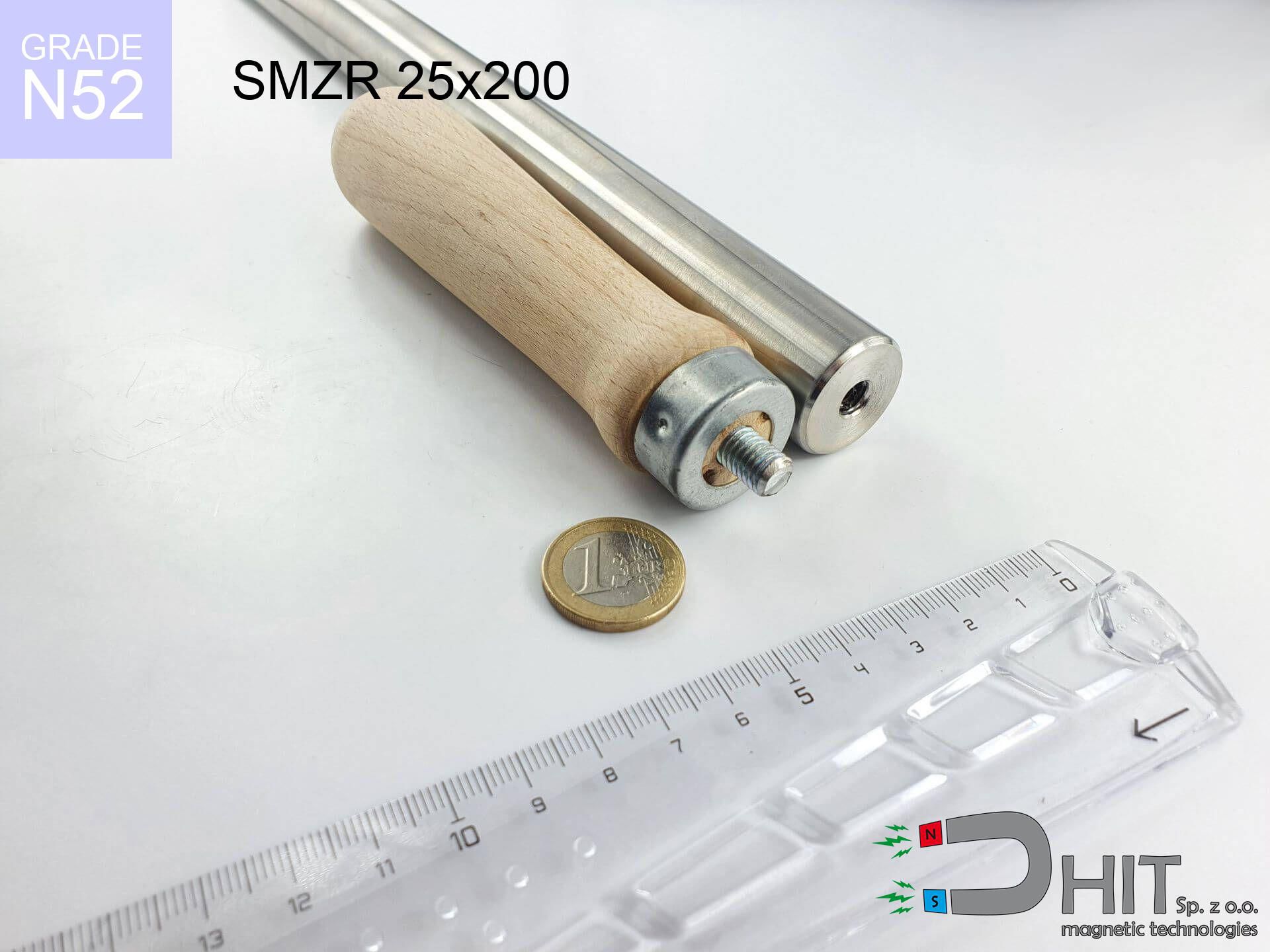MW 25x2.5 / N38 - cylindrical magnet
cylindrical magnet
Catalog no 010449
GTIN/EAN: 5906301811121
Diameter Ø
25 mm [±0,1 mm]
Height
2.5 mm [±0,1 mm]
Weight
9.2 g
Magnetization Direction
↑ axial
Load capacity
2.55 kg / 25.03 N
Magnetic Induction
121.57 mT / 1216 Gs
Coating
[NiCuNi] Nickel
3.95 ZŁ with VAT / pcs + price for transport
3.21 ZŁ net + 23% VAT / pcs
bulk discounts:
Need more?Need advice?
Give us a call
+48 22 499 98 98
or contact us by means of
inquiry form
through our site.
Strength as well as appearance of magnetic components can be estimated with our
magnetic calculator.
Same-day shipping for orders placed before 14:00.
MW 25x2.5 / N38 - cylindrical magnet
Specification / characteristics MW 25x2.5 / N38 - cylindrical magnet
| properties | values |
|---|---|
| Cat. no. | 010449 |
| GTIN/EAN | 5906301811121 |
| Production/Distribution | Dhit sp. z o.o. |
| Country of origin | Poland / China / Germany |
| Customs code | 85059029 |
| Diameter Ø | 25 mm [±0,1 mm] |
| Height | 2.5 mm [±0,1 mm] |
| Weight | 9.2 g |
| Magnetization Direction | ↑ axial |
| Load capacity ~ ? | 2.55 kg / 25.03 N |
| Magnetic Induction ~ ? | 121.57 mT / 1216 Gs |
| Coating | [NiCuNi] Nickel |
| Manufacturing Tolerance | ±0.1 mm |
Magnetic properties of material N38
| properties | values | units |
|---|---|---|
| remenance Br [min. - max.] ? | 12.2-12.6 | kGs |
| remenance Br [min. - max.] ? | 1220-1260 | mT |
| coercivity bHc ? | 10.8-11.5 | kOe |
| coercivity bHc ? | 860-915 | kA/m |
| actual internal force iHc | ≥ 12 | kOe |
| actual internal force iHc | ≥ 955 | kA/m |
| energy density [min. - max.] ? | 36-38 | BH max MGOe |
| energy density [min. - max.] ? | 287-303 | BH max KJ/m |
| max. temperature ? | ≤ 80 | °C |
Physical properties of sintered neodymium magnets Nd2Fe14B at 20°C
| properties | values | units |
|---|---|---|
| Vickers hardness | ≥550 | Hv |
| Density | ≥7.4 | g/cm3 |
| Curie Temperature TC | 312 - 380 | °C |
| Curie Temperature TF | 593 - 716 | °F |
| Specific resistance | 150 | μΩ⋅cm |
| Bending strength | 250 | MPa |
| Compressive strength | 1000~1100 | MPa |
| Thermal expansion parallel (∥) to orientation (M) | (3-4) x 10-6 | °C-1 |
| Thermal expansion perpendicular (⊥) to orientation (M) | -(1-3) x 10-6 | °C-1 |
| Young's modulus | 1.7 x 104 | kg/mm² |
Physical analysis of the assembly - report
These data are the direct effect of a physical analysis. Values rely on models for the class Nd2Fe14B. Operational performance may differ from theoretical values. Please consider these data as a supplementary guide during assembly planning.
MW 25x2.5 / N38
| Distance (mm) | Induction (Gauss) / mT | Pull Force (kg) | Risk Status |
|---|---|---|---|
| 0 mm |
1216 Gs
121.6 mT
|
2.55 kg / 2550.0 g
25.0 N
|
strong |
| 1 mm |
1177 Gs
117.7 mT
|
2.39 kg / 2391.6 g
23.5 N
|
strong |
| 2 mm |
1121 Gs
112.1 mT
|
2.17 kg / 2166.6 g
21.3 N
|
strong |
| 3 mm |
1050 Gs
105.0 mT
|
1.90 kg / 1902.7 g
18.7 N
|
low risk |
| 5 mm |
887 Gs
88.7 mT
|
1.36 kg / 1358.4 g
13.3 N
|
low risk |
| 10 mm |
511 Gs
51.1 mT
|
0.45 kg / 450.5 g
4.4 N
|
low risk |
| 15 mm |
282 Gs
28.2 mT
|
0.14 kg / 137.4 g
1.3 N
|
low risk |
| 20 mm |
162 Gs
16.2 mT
|
0.05 kg / 45.4 g
0.4 N
|
low risk |
| 30 mm |
64 Gs
6.4 mT
|
0.01 kg / 7.0 g
0.1 N
|
low risk |
| 50 mm |
17 Gs
1.7 mT
|
0.00 kg / 0.5 g
0.0 N
|
low risk |
MW 25x2.5 / N38
| Distance (mm) | Friction coefficient | Pull Force (kg) |
|---|---|---|
| 0 mm | Stal (~0.2) |
0.51 kg / 510.0 g
5.0 N
|
| 1 mm | Stal (~0.2) |
0.48 kg / 478.0 g
4.7 N
|
| 2 mm | Stal (~0.2) |
0.43 kg / 434.0 g
4.3 N
|
| 3 mm | Stal (~0.2) |
0.38 kg / 380.0 g
3.7 N
|
| 5 mm | Stal (~0.2) |
0.27 kg / 272.0 g
2.7 N
|
| 10 mm | Stal (~0.2) |
0.09 kg / 90.0 g
0.9 N
|
| 15 mm | Stal (~0.2) |
0.03 kg / 28.0 g
0.3 N
|
| 20 mm | Stal (~0.2) |
0.01 kg / 10.0 g
0.1 N
|
| 30 mm | Stal (~0.2) |
0.00 kg / 2.0 g
0.0 N
|
| 50 mm | Stal (~0.2) |
0.00 kg / 0.0 g
0.0 N
|
MW 25x2.5 / N38
| Surface type | Friction coefficient / % Mocy | Max load (kg) |
|---|---|---|
| Raw steel |
µ = 0.3
30% Nominalnej Siły
|
0.76 kg / 765.0 g
7.5 N
|
| Painted steel (standard) |
µ = 0.2
20% Nominalnej Siły
|
0.51 kg / 510.0 g
5.0 N
|
| Oily/slippery steel |
µ = 0.1
10% Nominalnej Siły
|
0.26 kg / 255.0 g
2.5 N
|
| Magnet with anti-slip rubber |
µ = 0.5
50% Nominalnej Siły
|
1.28 kg / 1275.0 g
12.5 N
|
MW 25x2.5 / N38
| Steel thickness (mm) | % power | Real pull force (kg) |
|---|---|---|
| 0.5 mm |
|
0.26 kg / 255.0 g
2.5 N
|
| 1 mm |
|
0.64 kg / 637.5 g
6.3 N
|
| 2 mm |
|
1.28 kg / 1275.0 g
12.5 N
|
| 5 mm |
|
2.55 kg / 2550.0 g
25.0 N
|
| 10 mm |
|
2.55 kg / 2550.0 g
25.0 N
|
MW 25x2.5 / N38
| Ambient temp. (°C) | Power loss | Remaining pull | Status |
|---|---|---|---|
| 20 °C | 0.0% |
2.55 kg / 2550.0 g
25.0 N
|
OK |
| 40 °C | -2.2% |
2.49 kg / 2493.9 g
24.5 N
|
OK |
| 60 °C | -4.4% |
2.44 kg / 2437.8 g
23.9 N
|
|
| 80 °C | -6.6% |
2.38 kg / 2381.7 g
23.4 N
|
|
| 100 °C | -28.8% |
1.82 kg / 1815.6 g
17.8 N
|
MW 25x2.5 / N38
| Gap (mm) | Attraction (kg) (N-S) | Repulsion (kg) (N-N) |
|---|---|---|
| 0 mm |
4.47 kg / 4472 g
43.9 N
2 302 Gs
|
N/A |
| 1 mm |
4.35 kg / 4351 g
42.7 N
2 398 Gs
|
3.92 kg / 3916 g
38.4 N
~0 Gs
|
| 2 mm |
4.19 kg / 4194 g
41.1 N
2 355 Gs
|
3.77 kg / 3775 g
37.0 N
~0 Gs
|
| 3 mm |
4.01 kg / 4009 g
39.3 N
2 302 Gs
|
3.61 kg / 3608 g
35.4 N
~0 Gs
|
| 5 mm |
3.57 kg / 3574 g
35.1 N
2 173 Gs
|
3.22 kg / 3216 g
31.6 N
~0 Gs
|
| 10 mm |
2.38 kg / 2382 g
23.4 N
1 775 Gs
|
2.14 kg / 2144 g
21.0 N
~0 Gs
|
| 20 mm |
0.79 kg / 790 g
7.8 N
1 022 Gs
|
0.71 kg / 711 g
7.0 N
~0 Gs
|
| 50 mm |
0.03 kg / 30 g
0.3 N
198 Gs
|
0.03 kg / 27 g
0.3 N
~0 Gs
|
MW 25x2.5 / N38
| Object / Device | Limit (Gauss) / mT | Safe distance |
|---|---|---|
| Pacemaker | 5 Gs (0.5 mT) | 8.0 cm |
| Hearing aid | 10 Gs (1.0 mT) | 6.0 cm |
| Mechanical watch | 20 Gs (2.0 mT) | 5.0 cm |
| Mobile device | 40 Gs (4.0 mT) | 4.0 cm |
| Car key | 50 Gs (5.0 mT) | 3.5 cm |
| Payment card | 400 Gs (40.0 mT) | 1.5 cm |
| HDD hard drive | 600 Gs (60.0 mT) | 1.0 cm |
MW 25x2.5 / N38
| Start from (mm) | Speed (km/h) | Energy (J) | Predicted outcome |
|---|---|---|---|
| 10 mm |
18.55 km/h
(5.15 m/s)
|
0.12 J | |
| 30 mm |
29.13 km/h
(8.09 m/s)
|
0.30 J | |
| 50 mm |
37.55 km/h
(10.43 m/s)
|
0.50 J | |
| 100 mm |
53.10 km/h
(14.75 m/s)
|
1.00 J |
MW 25x2.5 / N38
| Technical parameter | Value / Description |
|---|---|
| Coating type | [NiCuNi] Nickel |
| Layer structure | Nickel - Copper - Nickel |
| Layer thickness | 10-20 µm |
| Salt spray test (SST) ? | 24 h |
| Recommended environment | Indoors only (dry) |
MW 25x2.5 / N38
| Parameter | Value | SI Unit / Description |
|---|---|---|
| Magnetic Flux | 7 872 Mx | 78.7 µWb |
| Pc Coefficient | 0.16 | Low (Flat) |
MW 25x2.5 / N38
| Environment | Effective steel pull | Effect |
|---|---|---|
| Air (land) | 2.55 kg | Standard |
| Water (riverbed) |
2.92 kg
(+0.37 kg Buoyancy gain)
|
+14.5% |
1. Vertical hold
*Warning: On a vertical surface, the magnet holds only ~20% of its max power.
2. Steel saturation
*Thin metal sheet (e.g. computer case) significantly weakens the holding force.
3. Temperature resistance
*For N38 material, the max working temp is 80°C.
4. Demagnetization curve and operating point (B-H)
chart generated for the permeance coefficient Pc (Permeance Coefficient) = 0.16
This simulation demonstrates the magnetic stability of the selected magnet under specific geometric conditions. The solid red line represents the demagnetization curve (material potential), while the dashed blue line is the load line based on the magnet's geometry. The Pc (Permeance Coefficient), also known as the load line slope, is a dimensionless value that describes the relationship between the magnet's shape and its magnetic stability. The intersection of these two lines (the black dot) is the operating point — it determines the actual magnetic flux density generated by the magnet in this specific configuration. A higher Pc value means the magnet is more 'slender' (tall relative to its area), resulting in a higher operating point and better resistance to irreversible demagnetization caused by external fields or temperature. A value of 0.42 is relatively low (typical for flat magnets), meaning the operating point is closer to the 'knee' of the curve — caution is advised when operating at temperatures near the maximum limit to avoid strength loss.
Chemical composition
| iron (Fe) | 64% – 68% |
| neodymium (Nd) | 29% – 32% |
| boron (B) | 1.1% – 1.2% |
| dysprosium (Dy) | 0.5% – 2.0% |
| coating (Ni-Cu-Ni) | < 0.05% |
Environmental data
| recyclability (EoL) | 100% |
| recycled raw materials | ~10% (pre-cons) |
| carbon footprint | low / zredukowany |
| waste code (EWC) | 16 02 16 |
Other deals
Advantages and disadvantages of Nd2Fe14B magnets.
Advantages
- They virtually do not lose power, because even after 10 years the performance loss is only ~1% (according to literature),
- They feature excellent resistance to weakening of magnetic properties as a result of external fields,
- A magnet with a shiny nickel surface is more attractive,
- The surface of neodymium magnets generates a concentrated magnetic field – this is a key feature,
- Due to their durability and thermal resistance, neodymium magnets can operate (depending on the form) even at high temperatures reaching 230°C or more...
- Possibility of accurate machining as well as adjusting to specific applications,
- Universal use in future technologies – they find application in data components, electric motors, medical equipment, as well as modern systems.
- Thanks to efficiency per cm³, small magnets offer high operating force, with minimal size,
Limitations
- To avoid cracks upon strong impacts, we suggest using special steel holders. Such a solution secures the magnet and simultaneously improves its durability.
- We warn that neodymium magnets can reduce their strength at high temperatures. To prevent this, we recommend our specialized [AH] magnets, which work effectively even at 230°C.
- When exposed to humidity, magnets usually rust. For applications outside, it is recommended to use protective magnets, such as those in rubber or plastics, which secure oxidation as well as corrosion.
- Limited possibility of producing nuts in the magnet and complicated forms - recommended is a housing - mounting mechanism.
- Health risk to health – tiny shards of magnets pose a threat, if swallowed, which gains importance in the context of child health protection. It is also worth noting that small elements of these magnets are able to be problematic in diagnostics medical when they are in the body.
- High unit price – neodymium magnets have a higher price than other types of magnets (e.g. ferrite), which increases costs of application in large quantities
Lifting parameters
Highest magnetic holding force – what it depends on?
- using a sheet made of low-carbon steel, serving as a ideal flux conductor
- with a thickness of at least 10 mm
- with a surface free of scratches
- without any air gap between the magnet and steel
- during detachment in a direction perpendicular to the mounting surface
- at ambient temperature approx. 20 degrees Celsius
Magnet lifting force in use – key factors
- Gap (between the magnet and the plate), because even a microscopic clearance (e.g. 0.5 mm) results in a reduction in force by up to 50% (this also applies to paint, corrosion or dirt).
- Direction of force – highest force is obtained only during pulling at a 90° angle. The force required to slide of the magnet along the surface is typically several times smaller (approx. 1/5 of the lifting capacity).
- Base massiveness – too thin plate does not close the flux, causing part of the power to be escaped to the other side.
- Steel grade – ideal substrate is high-permeability steel. Hardened steels may generate lower lifting capacity.
- Surface condition – ground elements ensure maximum contact, which improves force. Uneven metal reduce efficiency.
- Temperature – temperature increase causes a temporary drop of force. Check the maximum operating temperature for a given model.
Holding force was checked on a smooth steel plate of 20 mm thickness, when a perpendicular force was applied, however under parallel forces the lifting capacity is smaller. In addition, even a minimal clearance between the magnet’s surface and the plate lowers the load capacity.
This is not a toy
Neodymium magnets are not toys. Swallowing several magnets may result in them attracting across intestines, which constitutes a direct threat to life and requires immediate surgery.
Mechanical processing
Dust generated during machining of magnets is flammable. Avoid drilling into magnets without proper cooling and knowledge.
Pinching danger
Large magnets can smash fingers in a fraction of a second. Do not put your hand betwixt two strong magnets.
Do not overheat magnets
Monitor thermal conditions. Heating the magnet to high heat will destroy its magnetic structure and strength.
Compass and GPS
Remember: rare earth magnets produce a field that disrupts precision electronics. Keep a separation from your mobile, tablet, and navigation systems.
Data carriers
Avoid bringing magnets close to a purse, computer, or TV. The magnetism can destroy these devices and wipe information from cards.
Nickel coating and allergies
Warning for allergy sufferers: The Ni-Cu-Ni coating contains nickel. If an allergic reaction appears, immediately stop handling magnets and use protective gear.
Danger to pacemakers
Patients with a ICD must maintain an large gap from magnets. The magnetic field can disrupt the operation of the life-saving device.
Risk of cracking
Despite the nickel coating, neodymium is brittle and cannot withstand shocks. Do not hit, as the magnet may shatter into sharp, dangerous pieces.
Caution required
Handle with care. Rare earth magnets act from a distance and snap with massive power, often quicker than you can react.


